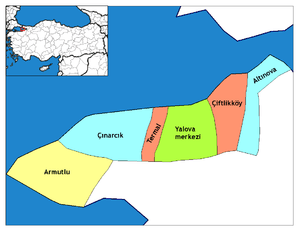Yalova
Yalova is a city located in northwestern Turkey, near the eastern coast of the Sea of Marmara. Yalova has a city population of 100,863, while the population of Yalova Province is 118,998[3] as of 2011. Currently there is a controversy around the municipal election results in Yalova especially after the Supreme Election Board invalidated the 2014 Municipal Election results on April 24, 2014 after a few recounts that changed results.[4]
Yalova | |
|---|---|
 Yalova  Yalova 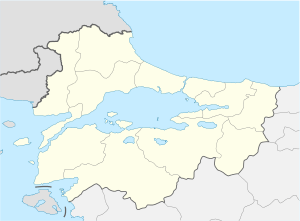 Yalova | |
| Coordinates: 40°39′20″N 29°16′30″E | |
| Country | Turkey |
| Province | Yalova |
| Government | |
| • Mayor | Vefa Salman, CHP |
| Area | |
| • District | 166.85 km2 (64.42 sq mi) |
| Elevation | 30 m (100 ft) |
| Population (2012)[2] | |
| • Urban | 102,874 |
| • District | 121,479 |
| • District density | 730/km2 (1,900/sq mi) |
| Website | www.yalova.bel.tr |
Etymology
In general, it is assumed that the name Yalova comes from Yalıova.[5] Yalı means 'house at the coast' and ova means 'plain' in Turkish.
History
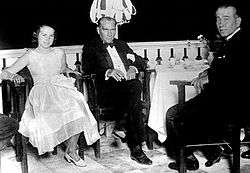
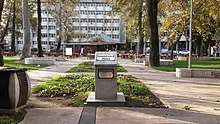
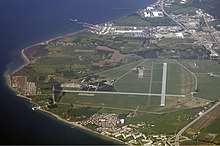
Ancient Yalova
The first settlement in the region dates back to the Prehistoric Period, in around 3000 BC. The Hittites ruled the region in the 21st century BC, followed by the Phrygians in the 13th century BC, and thereafter by the Greeks in the archaic, classical and Hellenistic eras. The region was conquered by the Romans in 74 BC. After the fall of the Roman Empire, the city was part of the Byzantine Empire.
In Antiquity and for most of the Middle Ages, the town was known as Pylae or Pylai (Greek: Πύλαι), in Bithynia, which is Greek for "gates", as it was at the start of one of the main routes leading into Asia for whomever crossed the Sea of Marmara from Europe.[6]
Middle Ages
In the Byzantine period the town remained of some importance due to its geographic location, and emperors frequently used it as a disembarkation point from Constantinople. Thus Emperor Heraclius landed here in 622, at the beginning of his counter-offensive against the Persians, and Romanos IV Diogenes did the same in 1071, on his way to the Battle of Manzikert.[6] In the 9th century, the town was also the site of one of the beacons that transmitted news from the frontier with the Abbasid Caliphate, and included an imperial hostel for travellers. In the late 10th century, however, Leo of Synada described Pylae as little more than a village, where cattle, horses, pigs and other animals were gathered to be shipped to Constantinople.[6]
The town and the surrounding district were raided by the Seljuk Turks after Manzikert, but soon recovered. In 1147, Greek refugees from Phrygia were settled there. In 1199 charter of privileges to Venetian merchants, it is attested along with neighbouring Pythia Therma as a separate fiscal district (episkepsis), and was a separate province by the time of the Fourth Crusade (1204).[6] Following the fall of Constantinople to the Crusaders, Pylae formed part of the Empire of Nicaea, and served as the main port for Nicaea itself.[6] Pylae remained in Byzantine hands until ca. 1302, when Turkish attacks grew in intensity, forcing much of the population to abandon it and seek refuge in the Princes' Islands.[6]
Modern
Shortly after, Yalova was incorporated into the territory of the Ottoman Empire. It was part of Sanjak of Kocaeli and was known as successively "Yalakabad" and "Yalıova". According to the Ottoman population statistics of 1914, the kaza of Yalova had a total population of 21.532, consisting of 10.274 Greeks, 7.954 Muslims and 3.304 Armenians.[7] It was occupied by Greek troops on 5 September 1920 during Turkish War of Independence.[8] During the occupiation, Massacres in Yalova peninsula occurred. Greek troops, who stationed in Adapazarı, Sapanca, Kandıra, İzmit, Karamürsel and Yalova were begun to move initially Bursa, later Eskişehir region after Greek defeat at Second Battle of İnönü for concentrating ones at line of Bursa-Uşak and attacking Turkish ones, which concantrated in Afyonkarahisar, Eskiehir and Kütahya. Turkish troops, who waited beyond Sakarya River, used this opportunity and attacked loosened Greek ones. Adapazarı was liberated on 26 June 1921,[9] İzmit on 28 June 1921 and finally Yalova on 19 July 1921.[10] It was initially county centre in Karamürsel district of Kocaeli Province. It became a district centre in Istanbul Province in 1930 after joining 2 villages from Orhangazi before becoming a province centre in 1995.
Mustafa Kemal Atatürk occasionally lived in Yalova in his final years. In one of his speeches he famously said: "Yalova is my city."
Since the second half of the 19th century, a large number of Avar muhajirs live in the city
Tourist attractions
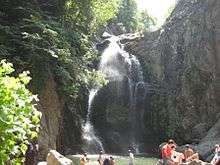
.jpg)
Yalova has a number of tourist attractions, such as the "Yalova Atatürk Mansion" used by Mustafa Kemal Atatürk, the founder of the modern Turkey, during his visits to the city.
There are also numerous new cultural centres, such as the Raif Dinçkök Cultural Centre and Cem Kültür House.
The city is known for its hot springs in the Termal district, which gets its name from the Greek word θερμαί 'warm'.
Another attraction is the Karaca Arboretum on the way to Termal.
The Yalova Earthquake Monument is situated in the 17 August Park at the coast of Marmara Sea.
Climate
Yalova has a borderline mediterranean/humid subtropical climate (Köppen climate classification: Csa/Cfa), with mild and wet winters and hot, humid summers.
| Climate data for Yalova | |||||||||||||
|---|---|---|---|---|---|---|---|---|---|---|---|---|---|
| Month | Jan | Feb | Mar | Apr | May | Jun | Jul | Aug | Sep | Oct | Nov | Dec | Year |
| Record high °C (°F) | 25.1 (77.2) |
27.2 (81.0) |
31.4 (88.5) |
36.5 (97.7) |
34.2 (93.6) |
42.1 (107.8) |
45.4 (113.7) |
40.0 (104.0) |
37.5 (99.5) |
36.6 (97.9) |
29.0 (84.2) |
27.4 (81.3) |
45.4 (113.7) |
| Average high °C (°F) | 10.3 (50.5) |
10.5 (50.9) |
12.7 (54.9) |
17.2 (63.0) |
21.7 (71.1) |
26.4 (79.5) |
28.8 (83.8) |
28.9 (84.0) |
25.4 (77.7) |
20.7 (69.3) |
15.8 (60.4) |
12.0 (53.6) |
19.2 (66.6) |
| Average low °C (°F) | 3.3 (37.9) |
3.1 (37.6) |
4.5 (40.1) |
8.0 (46.4) |
11.9 (53.4) |
15.9 (60.6) |
18.0 (64.4) |
18.3 (64.9) |
15.0 (59.0) |
11.8 (53.2) |
7.7 (45.9) |
5.2 (41.4) |
10.2 (50.4) |
| Record low °C (°F) | −5.9 (21.4) |
−11.0 (12.2) |
−7.4 (18.7) |
−1.6 (29.1) |
1.2 (34.2) |
8.0 (46.4) |
10.8 (51.4) |
10.6 (51.1) |
6.2 (43.2) |
1.3 (34.3) |
−3.2 (26.2) |
−5.6 (21.9) |
−11.0 (12.2) |
| Average precipitation mm (inches) | 86.9 (3.42) |
69.8 (2.75) |
69.5 (2.74) |
53.0 (2.09) |
33.8 (1.33) |
41.7 (1.64) |
22.4 (0.88) |
36.9 (1.45) |
52.9 (2.08) |
89.0 (3.50) |
89.2 (3.51) |
107.2 (4.22) |
752.3 (29.61) |
| Average rainy days | 15.6 | 13.3 | 12.3 | 11.1 | 7.6 | 6.0 | 4.2 | 4.3 | 6.3 | 10.8 | 12.6 | 14.5 | 118.6 |
| Mean monthly sunshine hours | 58.9 | 86.8 | 133.3 | 171 | 235.6 | 273 | 294.5 | 279 | 222 | 155 | 78 | 46.5 | 2,033.6 |
| Source: Devlet Meteoroloji İşleri Genel Müdürlüğü [11] | |||||||||||||
International relations
Twin towns — sister cities
Yalova is twinned with:[12]


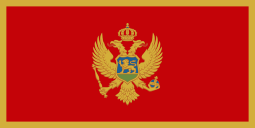







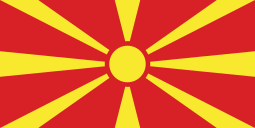

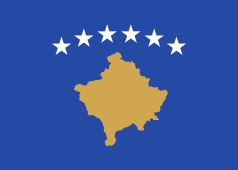






Notable natives
- Sarkis Minassian - Armenian journalist, killed in the Armenian Genocide
- Muharrem İnce - Politician
- İzel (İzel Çeliköz) - Singer
- Mehmet Okur - NBA basketball player
- Şebnem Ferah - Singer
References and notes
- "Area of regions (including lakes), km²". Regional Statistics Database. Turkish Statistical Institute. 2002. Retrieved 2013-03-05.
- "Population of province/district centers and towns/villages by districts - 2012". Address Based Population Registration System (ABPRS) Database. Turkish Statistical Institute. Retrieved 2013-02-27.
- "Archived copy". Archived from the original on 2015-09-20. Retrieved 2017-06-25.CS1 maint: archived copy as title (link)
- TDK Online - Yalı entry Archived 2007-12-25 at Archive.today
- Foss, Clive (1991). "Pylai". In Kazhdan, Alexander (ed.). The Oxford Dictionary of Byzantium. Oxford and New York: Oxford University Press. p. 1760. ISBN 978-0-19-504652-6.
- Kemal Karpat (1985), Ottoman Population, 1830-1914, Demographic and Social Characteristics, The University of Wisconsin Press, p. 184-185
- http://www.atam.gov.tr/dergi/sayi-54/kurtulus-savasi-doneminde-kocaeli-yalova-iznik-cevresinde-rum-ve-ermeni-teroru
- http://www.atam.gov.tr/dergi/sayi-45/isgal-yillarinda-adapazari-kazasinda-yunan-mezalimi
- http://www.yalovamiz.com/article.php?id=3135
- "Archived copy". Archived from the original on 2011-01-19. Retrieved 2011-02-21.CS1 maint: archived copy as title (link)
- "Kardeş Şehirler". yalova.bel.tr (in Turkish). Yalova. Retrieved 2020-01-17.
External links
| Wikimedia Commons has media related to Yalova. |
